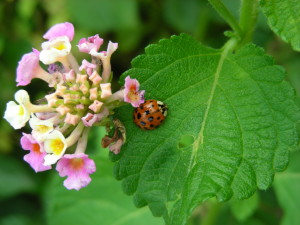 |
February 2015 Newsletter |
Backyard Beneficials
Beneficials in the Landscape
First off, let me mention that a pest is all a matter of perspective. There are insects that are commonly thought of as pests that can also be considered beneficial when viewed through the proper lens. An easy example would be termites. People are very unhappy when they find termites eating the cellulose material in their home, but in a natural setting, termites help break down cellulose material when trees fall in the forest. Of course, this works both ways. A flipped example is ladybird beetles. They are often called beneficial insects because they help to consume aphids and other small, soft-bodied insects that attack desired plants. I have seen ladybird beetles by the thousands enter my parents’ home to overwinter. These beetles are not the kind little helpers that ladybugs are made out to be- they dive bomb you, bite you and can stain fabrics with a fluid they exude. So keeping that in mind, let us proceed with a few “beneficials” you may find in the landscape.
Ladybird beetles a.k.a ladybugs
Ladybird beetle adults come in a variety of sizes and colors. Many of them are some shade of red and often have spots. Eggs are often laid in clusters near a food source, often aphids. The eggs are a yellowish-orange color and look like footballs sitting up on their end. Most larvae are elongated and a blackish-grey color with orange markings. Ladybird beetles pupate on the plant and pupae are non-moving. The adults and larvae are the stages that help to control soft-bodied pests such as aphids, whiteflies, mealybugs and scale insects.
Praying Mantises
Praying mantises are general predators in the nymphal and adult stages. They are also cannibalistic. Adults are fairly large insects with an elongated prothorax and front legs modified for capturing prey. Nymphs look similar to adults but are smaller and do not have fully developed wings. Adult females lay egg cases on small twigs and branches. At first the egg case looks like a frothy mass, but it soon hardens into an elongated, ridged case.
Spiders
Spiders are not insects, but arachnids. They have two body regions and eight legs which differentiates them from insects. Spiders are a large group with many shapes, colors and sizes. They are general predators as immatures and adults. For more information on specific spiders, see spider ID article from the May 2011 issue of the Compost Bin here:
http://www.tcmastergardeners.org/newsletter/2011/News2011.05.pdf
There are many more beneficial creatures that help keep pest populations in check. Before you decide to utilize a pesticide to manage a pest, take a closer look to see if nature is already controlling pests for you.
For more information or help with identification, contact Wizzie Brown, Texas AgriLife Extension Service Program Specialist at 512.854.9600. Check out my blog at www.urban-ipm.blogspot.com

